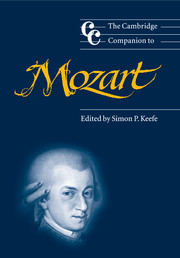Book contents
- Frontmatter
- Introduction
- Part I Mozart in context
- Part II The works
- 5 The keyboard music
- 6 The concertos in aesthetic and stylistic context
- 7 The orchestral music
- 8 Mozart's chamber music
- 9 Mozart as a vocal composer
- 10 The opere buffe
- 11 Mozart and opera seria
- 12 Mozart's German operas
- Part III Reception
- Part IV Performance
- Notes
- Selected further reading
- General index
- Index of Mozart’s works
7 - The orchestral music
from Part II - The works
Published online by Cambridge University Press: 28 September 2011
- Frontmatter
- Introduction
- Part I Mozart in context
- Part II The works
- 5 The keyboard music
- 6 The concertos in aesthetic and stylistic context
- 7 The orchestral music
- 8 Mozart's chamber music
- 9 Mozart as a vocal composer
- 10 The opere buffe
- 11 Mozart and opera seria
- 12 Mozart's German operas
- Part III Reception
- Part IV Performance
- Notes
- Selected further reading
- General index
- Index of Mozart’s works
Summary
Mozart was a prolific composer of orchestral music, writing numerous symphonies, divertimenti, serenades and cassations in the 1760s and 1770s, and six remarkable symphonies while based in Vienna in the 1780s. Although his contribution to the orchestral literature is predictably diverse, the genres in which he works are not as musically distinct in practical terms as nomenclature would seem to suggest. Divertimento, serenade and cassation each carried slightly different connotations in eighteenth-century Europe – according to the theorist Heinrich Christoph Koch the cassation was specifically designed for performance ‘in the evenings, outdoors, or on public streets’, for example – but Mozart uses the terms more or less interchangeably. Many of Mozart's Salzburg symphonies, too, are closely linked to his serenade and operatic overture repertories, the symphonies K.45, 87, 120, 135, 161/163, 121 and 102 either deriving from or being transformed into the overtures to Mozart's operas La finta semplice, Mitridate re di Ponto, Ascanio in Alba, Lucio Silla, Il sogno di Scipione, La finta giardiniera and Il re pastore respectively, and the cassation K.100 and the serenades K.204, 250 and 320 all reappearing in symphonic versions by Mozart or his father Leopold.
Irrespective of generic context, Mozart was acutely sensitive to matters of instrumentation and instrumental effect where orchestral writing was concerned. His meticulous attitude towards the spacing of chords in the wind section is evident not only in adjustments he makes to his own manuscripts, but also in amendments to the work of his pupil Thomas Attwood. Even in his very earliest compositions, Mozart is attuned to issues of orchestration, asking Nannerl to ‘remind me to give the horn something worthwhile to do’ in a symphony written in London in 1764. Throughout his life, in fact, Mozart reacts to orchestral colours and effects he witnesses at home and abroad. After experiencing the famed Mannheim orchestra first-hand in 1778, Mozart laments to his father: ‘Ah, if only we had clarinets too [in Salzburg]! You cannot imagine the glorious effect of a symphony with flutes, oboes and clarinets.’
- Type
- Chapter
- Information
- The Cambridge Companion to Mozart , pp. 92 - 104Publisher: Cambridge University PressPrint publication year: 2003



